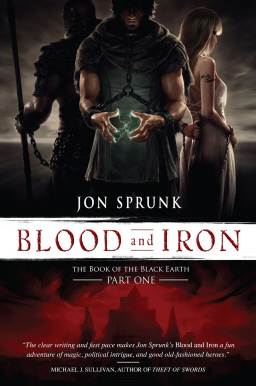The How’s and Why’s of Outlining
 Hello everyone. I’m Jon Sprunk and I’m an outline-a-holic.
Hello everyone. I’m Jon Sprunk and I’m an outline-a-holic.
I used to be a write-by-the-seat-of-my-pants – or pantser – once upon a time. After many false starts, I even managed to finally complete a novel manuscript with that method, although it took me nearly four years to revise it into something I could submit.
So that’s my first reason. Outlining has greatly cut down on my revision time. When I was pantsing it, I never had much idea about where the story was going beyond a vague notion about the main characters and their basic conflict. And so, after the first draft I had a huge pile of… well, stuff… and my next job was to sift through it for a coherent and consistent story. I had many scenes I couldn’t use, at least not in their original form, and many spots where I needed to go back and write new scenes to fill crucial gaps in the story. Not that I don’t still need to do those things as an outliner, but far less often.
The second reason is work ethic. Part of the reason it took me so long to finish projects as a pantser was that I’m the type of person who needs a plan in order to stay on-task. When I was just winging it, it was too easy to blow off the writing on any given day because it felt like an endless project. I need to see my progress, and word count is too abstract when I have no idea if my story would end up being 50,000 words or 500,000.
The third reason is that it’s a control issue. Having an outline in hand before I start a project makes me feel as if I have a roadmap with clear milestones along the way. It gives me a lot of comfort, knowing where the story is going from the start (and sometimes finding out I don’t even have a story before I start, which can be handy). So I don’t feel like I’m producing a chaotic mass of steaming crap, but something that has purpose.
Lastly, outlining is my personal technique for engaging both the creative and analytical sides of my brain up front. It’s a sort of “pre-season” for my writing. It gets me in the right mindset to write.
What is Outlining?
 For me, a story outline is a summary broken down by scenes. That’s how I conceptualize my novels and so I try to keep all the plot details at that level. I outline each of these scenes with a few sentences about what is happening, which characters are present, their motivations and goals, and even some snippets of dialogue if they come to me. I try to make sure that every scene has an arc with a beginning, middle, and end. It’s important that I know the conflict(s) present in each scene and how they are resolved at this time. Of course, for the heroes, the resolution for most scenes is: Things Get Worse!
For me, a story outline is a summary broken down by scenes. That’s how I conceptualize my novels and so I try to keep all the plot details at that level. I outline each of these scenes with a few sentences about what is happening, which characters are present, their motivations and goals, and even some snippets of dialogue if they come to me. I try to make sure that every scene has an arc with a beginning, middle, and end. It’s important that I know the conflict(s) present in each scene and how they are resolved at this time. Of course, for the heroes, the resolution for most scenes is: Things Get Worse!
Now that might sound elementary, and it is, but until I internalized that concept, my scenes were often weak and misleading without a strong emotional drive to propel the story forward.
I don’t use the old system we learned in school (I, II, A, B, 1, 2, 3…), but I do use bullet points. Lots and lots of bullet points. They are something of a fetish for me now.
So for Blood and Iron, the outline for the first scene was:
A ship at sea during a bad storm. It’s a transport vessel from Arnos, carrying troops to the east for the Great Crusade. Horace is the ship’s carpenter. During the storm, they are attacked by an Akeshian warship. The storm changes to bright green lightning and Horace feels weird. But then he’s swept overboard into the water. He thinks of his dead wife and son as he loses consciousness.
That’s it. You’ll notice I only mentioned enough detail to conjure the gist of the scene.
I outline the entire novel, from start to finish. Not just the main plot, but all the various subplots, too. By the end, I have a document that can be thirty pages long (9-pt font, single-spaced). I’ve heard from some authors that create longer outlines for their novels, and some that go quite a bit shorter. But that’s what works for me. You’ll find what works best for you.
Writing From An Outline
 Writing from an outline is fairly straightforward. I usually keep the outline file open on my computer while I write so I can go back and forth between it and my manuscript.
Writing from an outline is fairly straightforward. I usually keep the outline file open on my computer while I write so I can go back and forth between it and my manuscript.
As I write, I edit the outline, condensing the notes down to one or two sentences that contain the gist of the scene. This way, the outline becomes a brief scene-by-scene synopsis of the novel, which helps a lot because I hate writing synopses.
Still, even after outlining several novels, I don’t get it perfect. There were two spots in my outline for Blood and Iron where I had laid out the beginning of a scene, but nothing else. Now, for you pantsers, that might be an exciting thing full of unknown promise. For an obsessive outliner, it’s a moment of sheer panic, let me tell you. But sometimes it’s also an unexpected gift, because it forces me to stop and brainstorm anew, and good things often come from it.
Going Off the Rails
It’s almost inevitable. That after all the outlining and the preparing, that you’ll come to a point (or several points), right in the midst of a writing frenzy, when a better idea will occur to you. But there’s no rule that says an outline is iron-clad. When a better plot twist or a superior notion about the secret origin of the main character’s claustrophobic aunt occurs, it’s okay to go with it. Explore that new idea, because those sudden inspirations are what make writing so magical. Yes, sometimes they lead us into literary cul-de-sacs without a trail of breadcrumbs to get back, but more often than not the new idea eventually flows back into the original plot at some point, and now I have a delightful (or in my case, bloody and horrifying) little wrinkle in the story.
The Dangers of Outlining
Before we end, I’d like to mention some myths and pitfalls that can come with outlining.
The Creativity Gap: This is the one I hear about the most from writers who don’t outline, that outliners don’t have that creative spark where the prose hits the page. I’d like to put that notion to rest. Writing is writing, whether you’re working from an outline (itself a creative document) or coming at it cold. It’s about the moment, about the characters and their interactions and their conflicts. The presence of an outline doesn’t change that, any more than looking at a roadmap will actually transport you to another location – you still have to do the traveling yourself.
Procrastination. This one, sadly, is all too real. Because outlining gives you some of the joys of creation without all the mental and emotional heavy lifting of writing, it can be tempting to keep expanding the outline longer and longer, putting off the day when you have to actually get to work.
Uber-Compulsion. Some of us, myself included, are a bit compulsive. The outline can present the problem of becoming too much fun. Rather than spinning longer and longer outlines to put off the writing, we keep it going as an exercise of creative control, convincing ourselves that the more we outline before writing, the better the final product will be. But this is a trap. Once you’ve detailed the important points of each scene, it’s time to move on. Delving deeper is best done during the writing, and afterward during the revision phases, because that’s when you’ll really know what your story is about.
Outlining isn’t a silver bullet. It isn’t a magic technique that makes writing so simple a caveman could do it. It’s just one more tool in the writing toolbox. For me, it makes facing that blank computer screen with enough willpower to create on demand a little easier. And some days that makes it invaluable.
I’d love to hear from the other writers out there. Do you outline? How extensively? If not, what are your objections? There are no wrong answers in the exchange of perspectives.
Jon Sprunk is the author of the fantasy epic Blood and Iron as well as the Shadow Saga trilogy (Shadow’s Son, Shadow’s Lure, and Shadow’s Master). He’s also a mentor at the Seton Hill University fiction writing program. For more on his life and writing, check out www.jonsprunk.com.
I consider myself a pantser because I don’t exactly outline, but I sort of do. For one thing, I outline in my head, and while that might not be considered an actual outline, it works for me (at least so far). I know the beginning, the high points, and the ending. Along the way there will be occasional scenes added, ones for which I’d not planned, but they’re rare. Whenever I start paragraph one of a new project, I generally have a pretty good idea of how long it’s going to be, at least within a few thousand words.
And while I don’t start off with an actual outline, I do create one while writing. This allows me to remember when and where events happen, stuff like, “Oh, yeah, it was chapter seven when Castle Guard Bob stabbed that guy.”
Truth be known, though, I’ve been considering working out a strict outline for a longer project, just to test the waters, to see if I would enjoy the process.
I used to be one of those writers who objecte to myself outlining because I felt it diminished my creativity, but I eventually realized I’m already outlining, just in my head, so what’s the difference when I already know how things will turn out? Time will tell if I try a different approach, but I find the thought somewhat exciting.
This is pretty much how I do it too! It’s one way of preserving the pzazz of the original idea.
As a GM for many Roleplaying games over the years I can definitely say that the sessions I outlined beforehand were easily the best. Not only that they were much easier to run.
Sadly I rarely had time to do much more than ensure I had a basic idea of some plot to throw at the group. However even this was enough to get me going and some of the best moments were pure improvisation on my part(Flossy the Sheep of Death stands out)or that of my players (Turns out it is possible to have an entirely rational fear of the sea).
I say improvisation but I realise that a degree of worldbuilding was done before anything else – does this count as outlining?
I alternate between outlining and improvising, sometimes with long bouts of freewriting before I start to generate either attempts at story or attempts at structure. I’m best and fastest when my process is heaviest on pantsing, but even then, my outlining interludes are crucial to the overall product.
You know how Stephen King talks about “the guys in the basement,” and Elizabeth Bear talks about “the backbrain” as if it were an unruly collaborator who usually turns out to be right? It’s like that for me, and sometimes, when I’m very lucky, I get to experience something like Robert Louis Stevenson’s composition-by-lucid-dream. Or, as one of my oldest friends said half in jest, “You don’t need a dissociative disorder to write fiction, but it certainly helps.” It helps because I trust my whole brain together to be smarter than my prefrontal cortex is alone. I trust my process. It has a track record, which makes that easier.
Often, especially in longer projects, I find one character who is what a field anthropologist would call a “key informant,” a person who’s willing to talk to me, and then vouch for me to the rest of his or her community, until I can get access to all the people, settings, and details I need. If I want to find out about a character or a demographic that’s absent from the draft so far, I ask my key informant how to find that perspective. For a long time, my first novel had a lot of viewpoint characters, but none of them were disabled. In the world they lived in, where the ruling class has a hereditary malady as troubling as the Habsburgs’ hemophilia, this omission was a real problem. Hey, Haldur, I need to talk to one of the hidden ladies! He didn’t know any personally, but he worked his connections, and soon I got to meet someone who turned out to be one of my most devious, dangerous characters.
Before my kids were born, I used to come up with a lot of the day’s work while I slept. I’d wake myself up laughing at three in the morning, and usually whatever I had to scribble down so I could get back to sleep was still funny when I woke up. These days, I rarely sleep enough to remember what I dreamed, but eventually the kids will be older.
My first drafts are usually written longhand, with lots of crossing out, marginalia, and self-interruption. When I’m in a rough-draft-generating phase, I try to type up my longhand work as soon as possible after I’ve written in, and as I type, I’m already revising. When I hit a part of the book I haven’t seen yet, I skip it, make notes of the questions I need to ask the characters, and move on. Usually, the next longhand session I have gets me the stuff I couldn’t see. On occasion, I need to do more of my rough draft straight into my word processor, and although I get a final product that reads as well, it’s much slower and more frustrating for me than alternating between longhand and word processing.
This New York Times article about handwriting and the brain made me say, “Oh, of course!” a bunch of times.
@LordGarlack: Have you tried just mapping out the conflicts?
I love your process, Sarah. You seem to be very in-touch with your writer-brain/personality.